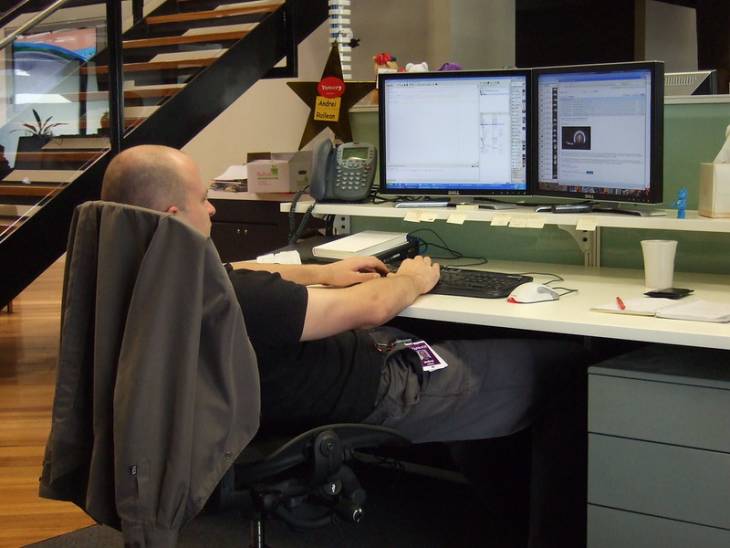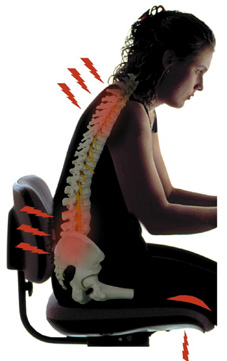7 Tips to Maintain Good Posture While Working at Your Desk

Man working at his desk in very bad posture. Photo: Yun Huang Yong/Flickr.
You may know it already, but it is worth emphasizing—good posture is very important for a healthy back! Sitting for long periods of time in bad postures puts pressure on the back and can cause back pains and other serious health problems.
It is important to maintain good posture to protect your back from disproportionate weight pressure leading to back issues, especially when at your workstation.
However, maintaining good posture while working at your desk will help you protect your back and keep your spine healthy. You will prevent the development of chronic back pain that can affect your ability to work and carry out your other day-to-day activities.
When you have good posture, your body is in the perfect position for proper weight distribution. This helps to prevent back pain that can be caused by the spine being twisted or compressed due to disproportionate pressure and weight.
How to Maintain Good Posture

Woman sitted in bad posture. Photo: Wikimedia.
Here are some top tips on how to maintain good posture while working at your desk:
1. Keep your ears aligned with your shoulders
Keep your ears in line with your shoulders and your back straight. Keep your weight evenly distributed between both feet and don't hunch over or tense up.
Slouching or leaning too far backward can cause lots of physical difficulties such as back and neck pain.
2. Practice small shoulder and chest exercises
Good posture is crucial for both our physical and mental health. It prolongs the longevity of our joints, spine, and muscles. One way to maintain good posture is by practicing small shoulder and chest exercises throughout the day.
Here’s a list of small exercises that are fun and easy to do. They help maintain good posture and are great for those who have desk jobs.
- Stretch your neck by tilting your head to the side and stretching it back.
- Small shoulders stretch by leaning forward, touching one hand to the ground while reaching out with the other arm.
- Chest stretch by sitting down, crossing one leg over the other and leaning forward.
3. Use an ergonomic chair and lumbar support pillows
Use an ergonomic chair or desk with proper height adjustment. An ergonomic chair helps you avoid back, neck, and shoulder pain, while preventing numbness from sitting too long in one position.
As noted by ergonomics and work station experts from Posturion, sitting is not the healthiest thing out there. As we sit longer and longer, we risk putting too much pressure on our backs, but you can make your work station as comfortable and productive as possible with the right ergonomic chair and support pillow.
Thus, another option is to use lumbar support pillows and cushions, which are great for providing the best posture when sitting down and can increase blood circulation.
4. Don't cross your legs when sitting
The correct way to sit in a chair is with two feet firmly on the floor, both knees pointing outwards, a straight back, head tilted slightly forward and arms resting at your sides.
That means you should not cross your legs while sitting. Slouching over your desk is also not good.

Bad posture of man slouching over a desk. Photo: Natalie Downe/Flickr
5. Take breaks to stand and walk around
One of the most common causes of poor posture is the use of a computer for long periods of time. This is especially important for those who spend hours at their desk, which is the case for many professionals.
One option is to take breaks from using your computer every 20 minutes or so and stand up and walk around.
6. Do some exercises to strengthen your spine muscles
Strengthening the muscles in your back, neck, and shoulders can help to improve your overall posture and alleviate pain and tension in the neck and shoulder regions.
Below are a few easy exercises for you to try at home or at the office:
Exercise #1 – Lateral Back Stretch
Lie on your back and pull both knees in towards your chest. Make sure that your feet are on the ground. Then, lean to one side as far as you can without straining or pulling muscles. Hold this position for 15-20 seconds before returning to start position and repeating on the other side.
Exercise #2 – Child’s Pose with Band
Sit down on a mat with your toes tucked under and bring yourself into child’s pose by sitting back onto your heels and extending out in front of you so that the tops of your feet rest just in front of where you are sitting.

Bad posture can lead to back pain. Photo: Getty Images.
7. Use a standing desk
Standing desks have become increasingly popular in the workplace over time, with many companies still offering standing desks for all of their employees.
Standing desks promote better posture and decrease the risk of obesity and cardiovascular diseases. Standing desks can help to prevent back pain, which is one of the most common illnesses among desk workers.
The best way to use a standing desk is with a laptop and an adjustable-height monitor that should be at eye level so that your neck does not strain when you're looking down at your laptop screen or reading documents.
You will also want to make sure you keep your lower back straight while working to avoid any discomfort in the long term.







![Understanding Business Insurance Policies: Key Terms and Definitions [node:title]](/sites/default/files/styles/front_featured__front_/public/business-insurance.jpeg?itok=ErsVEJiG)

![The True Cost of Business Break-Ins [node:title]](/sites/default/files/styles/front_featured__front_/public/hands-gloves-break-in-business-costs.jpeg?itok=p9V6IKqi)



























